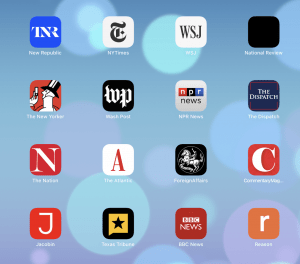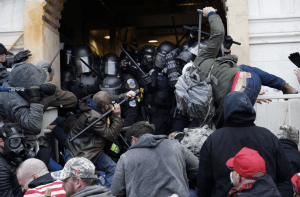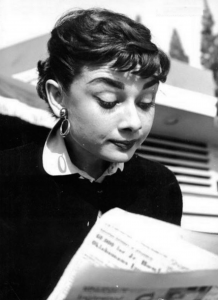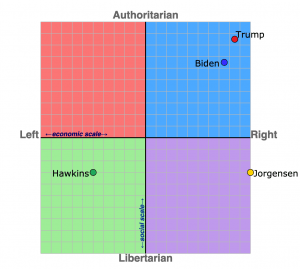Capitol Siege Analysis, due at noon, February 9, 2021, via Canvas
worth 40 points
Two to three pages, with 10 to 20 citations, looking at the role of social media in facilitating the events of January 6th at the capitol. Assignment specifics can be found on our class Canvas site.
Book Analysis, due at noon, March 21, 2021, via Canvas
worth 100 points
Choose one of these books:
Hofstadter, Richard. 1963. Anti-Intellectualism in American Life. New York: Vintage books.
Lim, Elvin. T. 2008. The Anti-Intellectual Presidency: The Decline of Presidential Rhetoric from George Washington to George W. Bush. New York: Oxford University Press.
Otto, Shawn. 2016. The War on Science: Who’s Waging It, Why It Matters, What We Can Do About It. Milkweed Editions.
Sagan, Carl. 1996. The Demon-Haunted World: Science as a Candle in the Dark. New York: Ballantine Books.
Shermer, Michael. 2015. The Moral Arc: How Science Makes Us Better People. Henry Holt and Co.
Jacobs, Alan. 2020. Breaking Bread with the Dead: A Reader’s Guide to a More Tranquil Mind. Penguin Press.
I might be willing to let you use another book, with my approval, if it is spot on relevant, and you promise you have not read it already.
Once you’ve read your book, you will write a really careful, 1250 word analysis (about five pages, double-spaced) in which you discuss the major themes, strengths, and weaknesses of the book with respect to current events in the last year or so and the ideas we’ve been discussing in class. Let me be very clear here: you will not pass this assignment if much of the content is not directly related to the stuff in the 2020-21 news. A simple report of what the author said in the book is not sufficient. Grading-wise, 80 of the 100 points in this assignment will go to content, and the other 20 points will go to mechanics. The content portion of your grade covers your ideas and analysis. Is the paper well reasoned? Is the exposition clear? Are any references authoritative? The mechanics portion of your grade covers grammar, spelling, punctuation, and correct citation of references. Weird fonts and margins annoy your grader. Cite sources in the style of the American Sociological Association.
News Consumption Action Plan, due at noon, April 11, 2021, via Canvas
worth 100 points
We have already seen this semester how damaging it can be to the project of well-reasoned, critical thinking for people to get all their information from inside their own bubble of like-minded thinkers. We have studied, in an academic mode, how political polarization is high, how respect for political pluralism and tolerance are low, and how none of that is good for democracy over the long haul. Now, a little praxis. For this assignment, students will identify a number of high quality print journalism outlets and promise to read them going forward. Proceed as follows.
1. Take the political orientation test found at Political Compass. Save a screen shot of the little chart generated at the end showing your placement on the two axes. It’ll look like this but have a dot for YOU in the appropriate spot:
2. Next, spend some time scrutinizing the charts assessing the bias of major news outlets available at AllSides and Ad Fontes.
3. Pick six to nine print journalism outlets (online and/or paper) that are good quality and show some range in political orientation. Look for good middle of the road outlets, and also a few well-respected liberal and conservative sources. You should not go to the nutty extremes of the left wing or right wing fringes. From center-left to center-right would work. Or stretch out to really liberal and really conservative, if your constitution can take it. But not all the way to crazypants in either direction.
Your sources may include newspapers, news websites, magazines that offer news and analysis from a partisan perspective, journals from political think tanks, etc. You should avoid (for the purposes of this assignment, and for the rest of your life) MSNBC and Fox, which are just divisive cheerleading outlets that make their money by doing worldview affirmation more than serious news and analysis. Under no circumstances should you consider social media sites like Twitter or Facebook as conscientious sources for news. The algorithms and quality controls of social media sites actually make people who use them for news, in my judgment, dumber and worse off than had they just sat quietly in a dark room.
I am especially interested in evaluating your choices of sources that differ from your own general political orientation. Indeed, HALF OF YOUR GRADE ON THIS ASSIGNMENT will come from your documenting a good faith effort to identify at least two sources of news/analysis that score on the “other side” from how you yourself score, as indicated by the Political Compass test. Style points for starting new paid subscriptions: good journalism costs money, and you should chip in.
4. Arrange the six to nine outlets in some logical way in a folder on your phone or tablet. Here are some I read, arranged in a way that makes sense to me:

5. Turn in a news consumption action plan that includes the screen shot of your political compass results and a screen shot of your phone or tablet folder showing the outlets you have selected. This document should then include a sentence or two in your own words for each outlet, explaining why you selected it, how it compares/contrasts to the others, and so forth. Again, I’m especially interested in hearing about your choices of sources that diverge from your own political leanings.
6. The last sentence or two of your action plan must answer this question: “Do you promise to regularly read and think about the articles in these outlets, especially the ones expressing views most dissimilar from your own?”
7. Upload the action plan to Canvas by the due date and time.
8. On the day of class after the written assignment is due, we will have “show and tell,” with students spending a few minutes describing their news folders and action plans. Fun!
Hoaxsters Analysis, due at noon, April 29, 2021, via Canvas
worth 100 points
Read Pluckrose, Lindsay, and Boghossion’s (PLB’s) description of their 20 paper hoax. Write an analysis of the hoax and its aftermath (now generally called the “grievance studies affair”) that addresses the following specific questions.
- What is the purpose of the university, and of the liberal arts, in 2021? [What’s the role of academia these days? Should college professors be doing teaching and research, or advocating for social justice, or both, or what?]
- Given your answer to question 1 above, did the “grievance studies” hoax amount to an attack on the liberal arts or a defense of the liberal arts? [Were PLB being anti-intellectual in challenging a now mainstream branch of academia, or were they convincingly calling out academics guilty of low standards, or dilettantism, or sophistry?]
- What are the most important political considerations of this whole affair? [How does this affair map onto the red state/blue state culture wars? Does it matter that, in general, American conservatives are more hostile to the modern university than are liberals, but PLB are themselves liberals? Are critical studies of the type targeted by PLB part of an admirable egalitarian project of extending equal rights to all, or an unhelpful diversion of energy into group based, tribal special pleading? Are so called “grievance studies” liberal or illiberal?]
- When, if ever, is an academic “sting” operation ethically permissible or necessary? [Why was the grievance studies affair in bounds or out of bounds?]
Make the paper conform to these parameters:
- Minimum 1000 words, excluding front and back matter like cover sheets and references.
- Minimum eight citations from appropriate sources, cited in APA or ASA style. For this assignment, in addition to scholarly treatments of general ideas like anti-intellectualism, academic hoaxes, etc., you may also want to refer to established, nationally recognized news and analysis outlets like the New York Times, Chronicle of Higher Education, The Atlantic for timely, specific coverage of this recent affair.
- One inch margins, double spaced, 12 point Times New Roman font.
“One More Thing…” due at noon, May 11, 2021, via Canvas
worth 60 points
Answer the three prompts below and email your paper to me at bobprice@txstate.edu no later than noon on May 11th. Papers should be typed up double-spaced, and any references need to be cited fully. An A student should be able to write an A paper in a couple of hours. I suspect A papers will be a few pages long. Not one or two pages, but not 10 pages either. Note that the prompts have different point values. You may not collaborate on this assignment.
- Which two ideas in Jacoby’s book do you find most true and useful? With which one idea from that book do you most disagree? Defend your choices. (Worth 30 points.)
- Describe some new idea you now have in your head because of this class. Pick something you didn’t just discuss in the previous prompt. (Worth 15 points.)
- Are we doomed? Explain. (Worth 15 points.)






